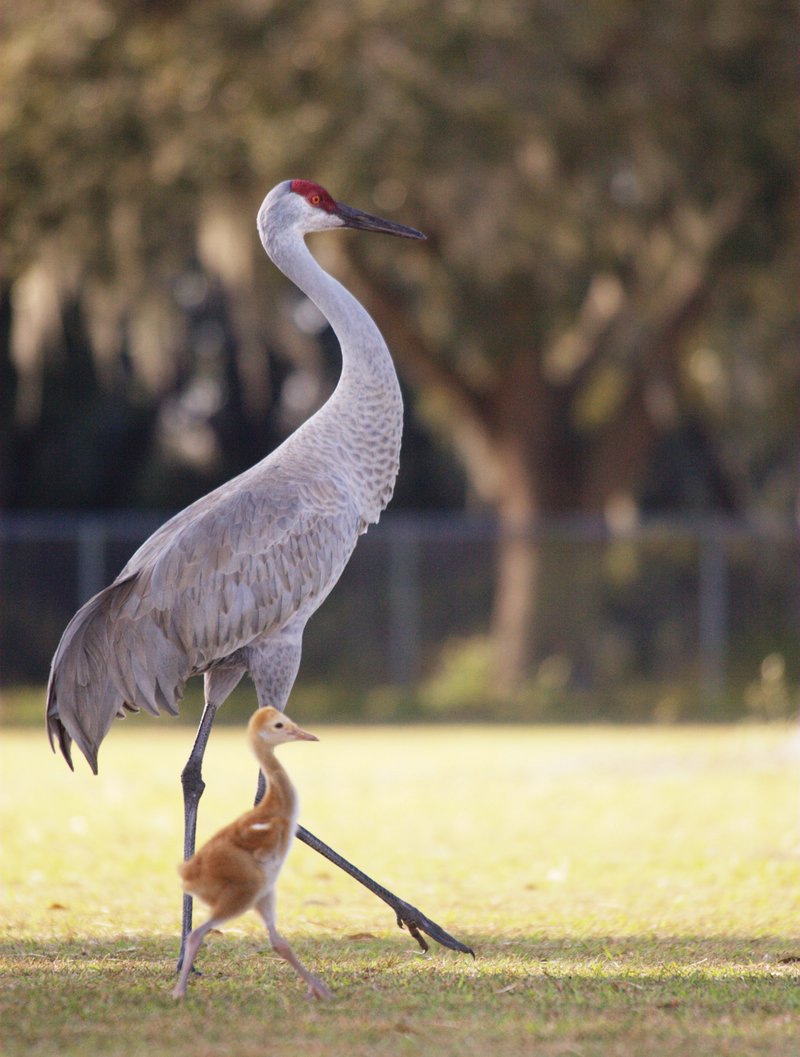| New Photos | Animal News | Animal Sounds | Animal Movies | Upload Photo | Copyright | Korean |
|---|
| Funny Animal Photos | Monsters in Animalia | Wiki Articles Fun Facts about Animals | Links | Home | Mobile A.P.A. |
|---|
| Image Info | Original File Name: Sandhill Crane (Grus canadensis)_with_baby.jpg Resolution: 2348x3102 File Size: 1039173 Bytes Date: 2007:02:17 16:22:18 Camera: Canon EOS 20D (Canon) F number: f/5.6 Exposure: 1/640 sec Focal Length: 262/1 Upload Time: 2008:01:04 19:55:26 | |
| Author | Name (E-mail): Unknown | |
| Subject | Sandhill Crane (Grus canadensis) - Wiki | |
 |
| Email : E-Card | Poster | Web Master Delete Edit Info Admin |
| Description | Sandhill Crane (Grus canadensis) - Wiki
Sandhill Crane
The Sandhill Crane (Grus canadensis) is a large crane of North America and extreme northeastern Siberia. They have the longest fossil history of any extant bird, with a 10 million year-old specimen having been found whose structure is identical to the modern Sandhill Crane. Adults are grey; they have a red forehead, white cheeks and a long dark pointed bill. They have long dark legs which trail behind in flight and a long neck that is kept straight in flight. Immature birds have reddish brown upperparts and grey underparts. The other large, grayish-bodied wader of North America is the Great Blue Heron. Although this heron is of similar dimensions to the sandhill and is sometimes given the misnomer "crane", it is extremely different in plumage, method of flight (it flies with its neck tucked towards the body instead of extended) and general structure. Size varies among the different races of Sandhill Cranes. A male of the race G. c. canadensis, or the Lesser Sandhill Crane averages 3.34 kg (7.4 lbs), 98 cm (39 in) in length and has a wingspan of 1.6 m (5.3 ft). A male of the race G. c. tabida or the Greater Sandhill Crane averages 5 kg (11 lbs), 119 cm (47 in) in length and has a wingspan of 2.12 m (7 ft). Both sexes look alike. Their breeding habitat is marshes and bogs in central and northern Canada, Alaska, part of the midwestern and southeastern United States, Siberia and Cuba. They nest in marsh vegetation or on the ground close to water. The female lays two eggs on a mound of vegetation. Cranes mate for life; both parents feed the young, called colts, who are soon able to feed themselves. The Sandhill Crane does not breed until it is two to seven years old. It can live up to 25 years in the wild; in captivity they have been known to live more than twice that span. Mated pairs stay together year round, and migrate south as a group with their offspring. In Allensworth, California is the location of a 6,833 acre grassland and wetland habitats Pixley National Wildlife Refuge. Of great interest, thousands of Sandhill Cranes use this refuge each winter from November through March. These birds forage while walking in shallow water or in fields, sometimes probing with their bills. They are omnivorous, eating insects, aquatic plants and animals, rodents, seeds and berries. Outside of the nesting season, they forage in large flocks, often in cultivated areas. This crane frequently gives a loud trumpeting call that suggests a French-style "r" rolled in the throat. Sandhill Cranes in flight can be differentiated from herons in that they fly with their necks extended, and by their nearly constant calls. Sandhills and Whooping Cranes Sandhill Cranes have been used as foster parents for Whooping Crane eggs and young in reintroduction schemes for that species, a project which failed as these foster-raised Whooping Cranes did not recognise other Whooping Cranes as their conspecifics???attempting instead, unsuccessfully, to pair with Sandhills. Subspecies Three subspecies are resident; pulla of the Gulf Coast of USA, pratensis of Florida and Georgia and nesiotes of Cuba. Others migrate to the southwestern United States south to Mexico. The Platte River at the edge of Nebraska's Sandhills in the American midwest is an important stopover for up to 450,000 of these birds during migration. This crane is a rare vagrant to China, South Korea and Japan and a very rare vagrant to western Europe. The Florida subspecies is often seen in residential yards and these birds seem little afraid of human approach. These visitors will eat shelled corn and commercially-purchased bird seed from the ground and from feeders. They may be seen in yards in north central Florida virtually year round, often in pairs or even pairs with a juvenile crane accompanying them. There are six subspecies recognized: - Lesser Sandhill Crane (G. c. canadensis) - Greater Sandhill Crane (G. c. tabida) - Canadian Sandhill Crane (G. c. rowani) - Florida Sandhill Crane (G. c. pratensis) - Mississippi Sandhill Crane (G. c. pulla) Endangered - Cuban Sandhill Crane (G. c. nesiotes) The Mississippi Sandhill Crane has become the first bird species to have a young hatched where an egg was fertilized by a sperm that was previously thawed out from a cryogenic state. This occurred at the Audobon Institute, and is meant to help remove this particular subspecies from the endangered list. http://en.wikipedia.org/wiki/Sandhill_Crane
| |||
| Copyright Info | AnimmalPicturesArchive.com does not have the copyright for this image. This photograph or artwork is copyright by the photographer or the original artist. If you are to use this photograph, please contact the copyright owner or the poster. |
|
|
|
| |||||||
| CopyLeft © since 1995, Animal Pictures Archive. All rights may be reserved. | ||||||||
Stats